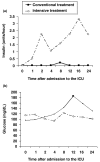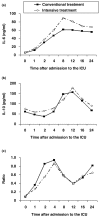Intensive insulin therapy does not alter the inflammatory response in patients undergoing coronary artery bypass grafting: a randomized controlled trial [ISRCTN95608630]
- PMID: 16356228
- PMCID: PMC1414017
- DOI: 10.1186/cc3911
Intensive insulin therapy does not alter the inflammatory response in patients undergoing coronary artery bypass grafting: a randomized controlled trial [ISRCTN95608630]
Abstract
Introduction: Strict control of plasma glucose in diabetic and non-diabetic patients has been shown to improve outcome in several clinical settings. There is extensive evidence that glucose can stimulate the production of pro-inflammatory cytokines such as tumor necrosis factor (TNF)-alpha and IL-6, with no effect on the anti-inflammatory cytokine IL-10. We hypothesized that strict glucose regulation results in a change in cytokine balance from a pro-inflammatory state to a more balanced anti-inflammatory condition. In a randomized controlled trial we studied the effect of strict glycemic control on the local and systemic pro-inflammatory and anti-inflammatory balance in non-diabetic patients undergoing elective coronary artery bypass grafting with cardiopulmonary bypass.
Methods: After surgery patients were randomly assigned to intensive insulin therapy (blood glucose between 80 and 110 mg/dl) or conventional insulin therapy (blood glucose less than 200 mg/dl). At 0, 1, 2, 4, 8, 12, 16 and 24 hours after admission to the intensive care unit, plasma samples and samples from the mediastinal drains were obtained. We measured the concentrations of the pro-inflammatory cytokines TNF-alpha and IL-6 and the anti-inflammatory cytokine IL-10 by enzyme-linked immunosorbent assay.
Results: Both patient groups were comparable in demographics, clinical characteristics and peri-operative data. In the intensive treatment group, glucose levels were significantly lower than in the conventionally treated group. No differences were found between both groups in the concentrations of TNF-alpha, IL-6 and IL-10 in plasma samples or in fluid draining the mediastinal cavity. Levels of IL-6 and IL-10 were significantly higher in mediastinal fluid samples than in plasma samples, suggesting a compartmentalized production of cytokines.
Conclusion: The protective effect of intensive insulin therapy in patients after cardiac surgery with cardiopulmonary bypass is not related to a change in cytokine balance from a pro-inflammatory to an anti-inflammatory pattern. Systemic cytokine levels are not representative of the local inflammatory response.
Figures



References
-
- Malmberg K, Ryden L, Efendic S, Herlitz J, Nicol P, Waldenstrom A, Wedel H, Welin L. Randomized trial of insulin-glucose infusion followed by subcutaneous insulin treatment in diabetic patients with acute myocardial infarction (DIGAMI study): effects on mortality at 1 year. J Am Coll Cardiol. 1995;26:57–65. doi: 10.1016/0735-1097(95)00126-K. - DOI - PubMed
-
- Malmberg K. Prospective randomised study of intensive insulin treatment on long term survival after acute myocardial infarction in patients with diabetes mellitus. DIGAMI (Diabetes Mellitus, Insulin Glucose Infusion in Acute Myocardial Infarction) Study Group. BMJ. 1997;314:1512–1515. - PMC - PubMed
-
- Iwasaka T, Takahashi N, Nakamura S, Sugiura T, Tarumi N, Kimura Y, Okubo N, Taniguchi H, Matsui Y, Inada M. Residual left ventricular pump function after acute myocardial infarction in NIDDM patients. Diabetes Care. 1992;15:1522–1526. - PubMed
-
- Malmberg K, Norhammar A, Wedel H, Ryden L. Glycometabolic state at admission: important risk marker of mortality in conventionally treated patients with diabetes mellitus and acute myocardial infarction: long-term results from the Diabetes and Insulin-Glucose Infusion in Acute Myocardial Infarction (DIGAMI) study. Circulation. 1999;99:2626–2632. - PubMed
Publication types
MeSH terms
Substances
Associated data
LinkOut - more resources
Full Text Sources
Medical

